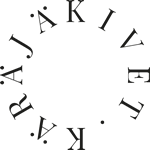KÄRÄJÄKIVET: A TERRITORIAL IMPRINT CONVERTED INTO AN EDITORIAL PROJECT
In 1978, the legendary Finnish artist Tapio Wirkkala drew an imaginary line across a hill in Lapland. An unfinished work, this project, imagined as a space for the introspection of peoples, is reinterpreted by a couple of Portuguese architects, in the form of an independent, democratic and non-commercial editorial project.
It all started in the north of Portugal in 2012. The economic crisis was in full swing and architectural opportunities were rare. This professional slowdown, for the most part distressing, is seen by two architects from Barcelos, a town near Braga, as the perfect opportunity to nourish their practice in a different way and invites them to accomplish an unprecedented project: documenting a work of art unfinished, little-known and misunderstood, designed on a territorial scale by the Finnish designer and sculptor Tapio Wirkkala in 1978 on one of the characteristic hills of the Lappish landscape, the Saivaara Monument.
Wirkkala had left only two sketches of this mysterious project: a straight, paved path, almost imperceptible, crossing the mountain along its entire length and crowned with a circle of stones at the summit. Yet his intentions were precise. He dreamed of creating a place of introspection where men of all races would converge to debate and reflect, like the ancient “Käräjäkivet” on which the village elders met to decide on common affairs.
On the ground, no trace allows us to glimpse this invisible territorial imprint. To highlight it, Márcia Nascimento and Nuno Costa decide to take up the challenge prefigured by Wirkkala and to explore the sides of this wild hill over several days of walking. Like that of archaeologists searching for an imaginary ruin, this slow exploration of the territory reveals itself as its author had imagined. The couple of architects are immersed in the immensity of the Sámi landscape and imbued with the primitive character specific to Finnish culture. Silence, introversion and constancy invade the two visitors. The first spatial representation of the monument designed by Wirkkala is not physical but spiritual.
The result of this artistic investigation spread over six years of research, this performance is presented to the public in 2018 through an exhibition composed of numerous sketches, drawings, photos and two territorial models. A year later, a first booklet was published “A Line in the Arctic Wilderness” by one of the project’s mentors, the famous Finnish architect Juhani Pallasma. The first “stone” of a modern Käräjäkivet has been laid and Wirkkala’s dream is reinterpreted in a literary key with the birth of the homonymous editorial series launched in 2019.
Just like the Finnish sculptor’s landscape action around the Saivaara fjeld, this publication collection attempts to create a space for multi-thematic dialogue. Finnish culture and its natural introversion are the only pretext for a series of authors to share in intimacy personal ideas on the culture of space and territory in their most archaic forms. Handcrafted by two designers converted into archaeologists of architectural thought, these brief literary constructions form a collection of anti-system manifestos that favor principles such as slowness, deepening and inward looking. Notions from another era that invite readers to get closer with their body, but especially their mind, to art, architecture and nature.
What initially was just a one-off trip to cover an invisible line in an uncertain landscape becomes over time, an opportunity to discreetly promote an independent culture that exists only for the pleasure of those who cultivate it in an introspective and disinterested manner. The “Käräjäkivet” publications exist for this type of audience and for all those who are not afraid of living more slowly.1
1. Yony Santos, “Käräjäkivet: une empreinte territoriale convertie en projet éditorial”, in espazium.ch, 2022.
